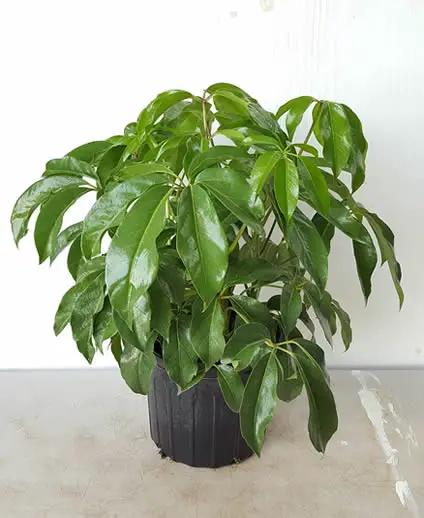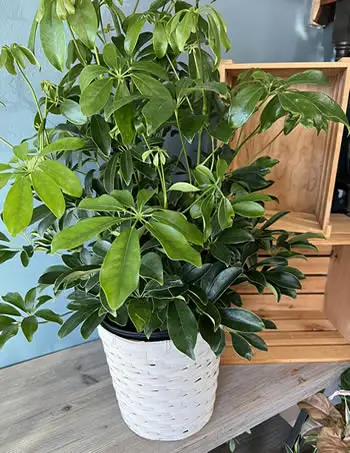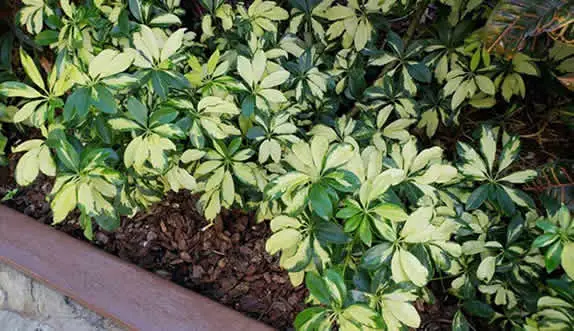Umbrella Plant Care: How to Grow This Lush, Tree-Like Houseplant Indoors and Out

The Umbrella Plant is a striking indoor tree that brings elegance and structure to your space with minimal fuss. With its glossy, hand-shaped leaves arranged like spokes on a wheel, it’s easy to see where the name comes from—it looks just like the top of a green umbrella.
Table of Contents
- Umbrella Plant Basics
- Light Needs: Bright, Filtered Light for Fast Growth
- Watering: Keep It Light and Steady
- Humidity and Temperature: Keep It Warm and Stable
- Fertilizer: Feed for Leafy Lushness
- Soil and Repotting: Choose a Loose, Well-Draining Mix
- Pruning and Maintenance: Shape It to Suit Your Space
- Best Spot in the Home: Bright Corners and Big Energy
- Outdoor Care: A Patio Tree in the Right Climate
- Common Problems and Fixes
- Final Thoughts
Umbrella Plant Basics
The term “umbrella plant” most often refers to two closely related species:
• Schefflera arboricola, also known as the Dwarf Umbrella Tree
• Schefflera actinophylla, the Australian Umbrella Tree

Both feature that signature radial leaf pattern and tree-like growth habit, but they differ in size and growth rate. S. arboricola is more compact, making it ideal for indoor growing, while S. actinophylla can reach towering heights and is more common in outdoor tropical landscapes.
You’ll also find named cultivars like:
• ‘Amate’, a glossy-leaved cultivar of S. actinophylla, prized for its vigorous indoor growth and resistance to pests
• ‘Hawaiian’, a popular name often used for S. arboricola in the houseplant trade
• Variegated forms, like S. arboricola ‘Gold Capella’ or ‘Trinette’, which bring bold splashes of yellow or cream to the foliage

Native to parts of Australia, Taiwan, and the Pacific Islands, umbrella plants grow in warm, humid forests and adapt beautifully to life in bright indoor spaces.
Their natural tolerance for pruning and shaping makes them one of the most versatile houseplants you can grow.
Light Needs: Bright, Filtered Light for Fast Growth
Umbrella Plants love bright, indirect light.
They’ll tolerate medium light conditions, but growth will be slower and leggier.
Avoid direct sunlight, especially during summer afternoons, as it can scorch the leaves.
If your plant starts leaning or stretching, it may need more light.
Rotate the pot regularly to encourage even, upright growth.
Watering: Keep It Light and Steady
Water your Schefflera when the top inch of soil feels dry.
These plants don’t like to sit in soggy soil, so it’s better to underwater than overwater.
In winter, reduce watering as growth slows.
If leaves begin to drop suddenly, either underwatering or overwatering could be to blame—check the soil before adjusting your routine.
Use filtered or distilled water if your tap water contains fluoride or salts, as Scheffleras can be sensitive to buildup over time.
Humidity and Temperature: Keep It Warm and Stable
Umbrella Plants thrive in average household humidity but will appreciate a boost in dry climates or during winter heating.
They prefer temperatures between 60°F and 75°F and dislike sudden cold drafts or prolonged dry air.

Mist occasionally, group with other plants, or use a pebble tray to help maintain moisture in the air around the plant.
Fertilizer: Feed for Leafy Lushness
During the growing season (spring through early fall), feed your Umbrella Plant every 4–6 weeks with a balanced liquid houseplant fertilizer.
A blend with an NPK ratio of 20-20-20 like this one, diluted to half strength is ideal.
Avoid fertilizing in winter, and don’t overfeed—excess salts can burn the roots and cause leaf drop.
Soil and Repotting: Choose a Loose, Well-Draining Mix
Use a standard indoor potting mix blended with perlite or coarse sand or vermiculite to improve drainage.
Repot every 2 to 3 years or when roots begin to circle the base of the pot.
Move up just one pot size at a time, and repot in spring for best results.
Pruning and Maintenance: Shape It to Suit Your Space
Scheffleras respond well to pruning, which helps keep them compact and encourages bushier growth.
Trim tall stems to control size or encourage branching, and remove any leggy, damaged, or overly long growth as needed.
Always use clean, sharp shears and cut just above a leaf node.
If your plant becomes bare or top-heavy, a good pruning can completely rejuvenate it.
Consider using your cuttings to grow new plants as we outline in our article How to Propagate Schefflera (Umbrella Plant) at Home.
Best Spot in the Home: Bright Corners and Big Energy
Umbrella Plants love bright living rooms, sunrooms, and home offices where they can spread out and soak in filtered sunlight.
They’re bold enough to stand alone in a room but also work beautifully with grouped greenery for a tropical effect.
Just don’t squeeze them into dark corners—they’re not shy about dropping leaves when unhappy.
Outdoor Care: A Patio Tree in the Right Climate
In USDA zones 10–12, Scheffleras can be grown outdoors year-round as shrubs or small trees.
In cooler climates, they can be moved outside in late spring when night temperatures stay above 60°F.

Place them in a shaded or dappled light location and avoid strong afternoon sun.
Water more frequently while outdoors and bring them back inside in early fall before the weather turns cool.
Check for pests and give the leaves a rinse before transitioning indoors.
Common Problems and Fixes
Leaf drop can be caused by drafts, overwatering, or under-lighting
Fix it by checking for temperature shifts, letting the soil dry slightly more, and increasing light
Yellowing leaves often mean overwatering or poor drainage
Fix it by adjusting your watering routine and making sure the pot isn’t holding excess water
Brown leaf edges may be from dry air or fertilizer buildup
Fix it by increasing humidity and flushing the soil with clean water every few months
Leggy stems usually point to low light or lack of pruning
Fix it by moving the plant to a brighter spot and trimming to encourage fuller growth
Pests like spider mites or aphids may show up in dry, dusty conditions
Fix it by wiping leaves clean regularly and treating with neem oil or insecticidal soap if needed
Final Thoughts
The Umbrella Plant is as reliable as it is stylish—fast-growing, easy to shape, and full of vibrant energy.
With bright light, steady watering, and the occasional trim, it will flourish as a lush, sculptural houseplant that brings personality and structure to any room.
And if you’re lucky enough to live somewhere warm, it’s just as happy to stretch its legs outdoors during the sunny season.
Thanks for reading! I'm Michael — houseplant fanatic and your Pinterest plant guide.
Follow me on Pinterest for fresh updates 🌿



